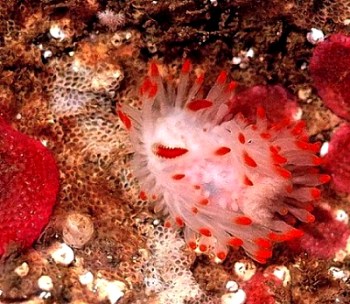
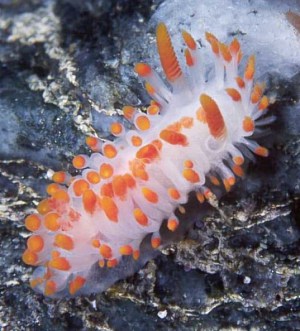
Limacia cockerelli
(MacFarland, 1905)
Order: NUDIBRANCHIA
Suborder: DORIDINA
Superfamily: ANADORIDOIDEA
Family: Polyceridae
Subfamily: Triophinae
DISTRIBUTION
West Coast of North America from Vancouver Island, British Columbia, Canada to Baja California, Mexico.
PHOTO
UPPER: Animal on its bryozoan prey, the orange brown colored Hincksina velata, at Cape Arago, Oregon, USA. [red colour form] Photo: Jeff Goddard.
LOWER: Shaw's Cove, Laguna Beach, California. [orange colour form] Photo: Bruce Wight.
This polycerid dorid, formerly known as Laila cockerelli, reaches lengths of 26 mm and preys exclusively on the thinly encrusting, orange brown colored bryozoan, Hincksina velata. Like its close relative, Crimora coneja, Limacia cockerelli uses its radula to rasp entire zooids out of their minute calcified compartments, leaving behind the white skeleton of the bryozoan. Also like Crimora coneja, Limacia cockerelli lays its spiral egg ribbons flat, instead of on edge like most other dorid nudibranchs. The eggs of Limacia cockerelli are pink and develop into hatching planktotrophic veligers after 17 days at 10-13 degrees C (Goddard, 1984).
Limacia cockerelli occurs in two color forms. The northern form, [upper photo], has white tubercles down the middle of the dorsum. In specimens from south of Point Conception [lower photo] these tubercles are slightly longer and tipped with orange. Intermediate forms occur in central and northern California. According to Behrens (1991), another form in California has large red blotches on the dorsum.
It is found from Vancouver Island, British Columbia, Canada to the southern of Baja California Sur, Mexico and has also been found at Bahia de Los Angeles in the Gulf of California.
Note added 25 Jan 2006: Laila MacFarland 1905 was synonymized with Limacia Muller, 1781, in Vallès et.al., 2000 so the genus name has been changed in this Fact Sheet. W.B.Rudman.
-
Vallès, Y.; Valdés, A.; Ortea, J. 2000. On the phanerobranch dorids of Angola (Mollusca, Nudibranchia): A crossroads of temperate and tropical species. Zoosystema, 22(1): 15-31.
-
Behrens, D.W. (1991) Pacific Coast Nudibranchs. Sea Challengers: Monterey, California.
-
Goddard, J.H.R. 1984. The opisthobranchs of Cape Arago, Oregon, with notes on their biology and a summary of benthic opisthobranchs known from Oregon. The Veliger, 27(2): 143-163.
-
Goddard, J.H.R. (1987) Observations on the opisthobranch mollusks of Punta Gorda, California, with notes on the distribution and biology of Crimora coneja. The Veliger, 29(3): 267-273.
-
Goddard, J.H.R. (1998) A summary of the prey of nudibranch molluscs from Cape Arago, Oregon. Opisthobranch Newsletter, 24: 11-14.
-
McDonald, G.W. (1983) A review of the nudibranchs of the California coast. Malacologia, 24: 114-276.
-
McDonald, G.R. & Nybakken, J.W. (1978) Additional notes on the food of some California nudibranchs with a summary of known food habits of California species. The Veliger, 21(1): 110-119.
-
Vallès, Y.; Valdés, A.; Ortea, J. 2000. On the phanerobranch dorids of Angola (Mollusca, Nudibranchia): A crossroads of temperate and tropical species. Zoosystema, 22(1): 15-31.
Goddard, J.H.R., 2000 (July 3) Limacia cockerelli (MacFarland, 1905). [In] Sea Slug Forum. Australian Museum, Sydney. Available from http://www.seaslugforum.net/find/lailcock
Related messages
Limacia cockerelli and scaleworm
September 24, 2008
From: Richard Zade
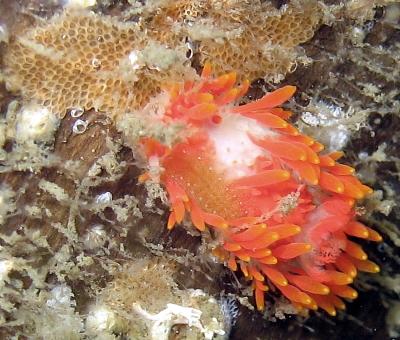
Concerning message #21390:
Here is a new association for you. A juvenile scaleworm on a Limacia cockerelli.
Locality: Port Townsend, 90 feet, Washington, USA, Puget Sound, 08-25-2008, Logs on a silty bottom. Length: ?. Photographer: Richard Zade.
Richard Zade
rzade@hotmail.com
Zade, R., 2008 (Sep 24) Limacia cockerelli and scaleworm. [Message in] Sea Slug Forum. Australian Museum, Sydney. Available from http://www.seaslugforum.net/find/21852Thanks Rich,
Good eyes. Now that folks are looking closer at sea slugs, this kind of association is becoming more common. The only problem is we don't understand what the association is. Is the worm feeding on the slug, or just walking over it.
Note to others, Rick is assisting, Bill Pence and Doug Mason, two high school science instructors in California, in a genetic study to determine whether the three color forms of this dorid, are distinct species themselves. External morphological differences suggest they might be, but internal anatomy is largely identical.
Thanks for sharing,
Dave Behrens
Limacia cockerelli laying eggs
August 15, 2008
From: Todd Aki
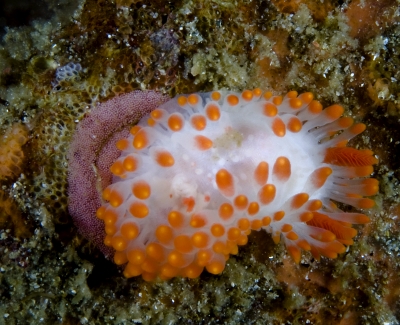
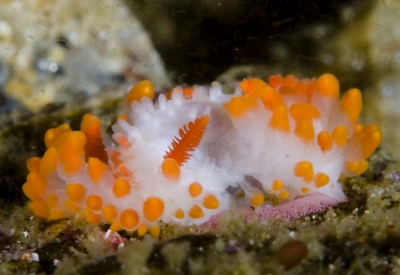
Hi Bill,
I photographed several different Limacia cockerelli but didn't that some of them were laying eggs until I saw the images on my computer.
Locality: Monterey Breakwater, 25 feet, California, Pacific Ocean, 02 May 2008. Length: 10-15 mm. Photographer: Todd Aki.
Thanks,
Todd
aki340@sbcglobal.net
Aki, T., 2008 (Aug 15) Limacia cockerelli laying eggs. [Message in] Sea Slug Forum. Australian Museum, Sydney. Available from http://www.seaslugforum.net/find/21793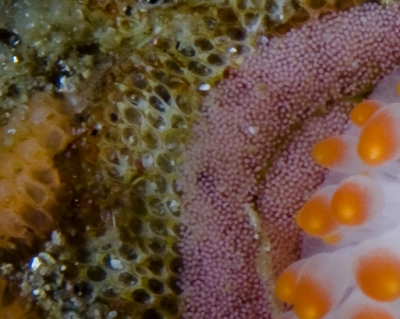
Dear Todd,
Thanks for these nice photos. The other thing you can see in your photos is the half eaten colony of their bryozoan prey, the orange brown colored Hincksina velata. In the close-up alongside you can see the orange living section of the colony, and the brownish white eaten section alongside the egg ribbon.
Best wishes,
Bill Rudman
Limacia cockerelli - colour variation
May 29, 2007
From: Roeland Papen
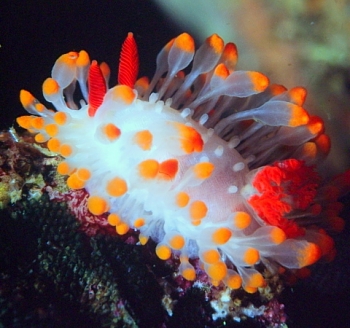
In looking up multiple images of Limacia cockerelli on the web and comparing it to the picture I am attaching I wandered if the different color varieties could be related to a geographic color change in its food source?
Locality: Breakwater, Monterey , 12 m, California, USA, Pacific Ocean, 29 April 2006, Rocky Breakwater. Length: 25 mm. Photographer: Roeland Papen.
Roeland Papen
roelandpapen@aol.com
Papen, R., 2007 (May 29) Limacia cockerelli - colour variation. [Message in] Sea Slug Forum. Australian Museum, Sydney. Available from http://www.seaslugforum.net/find/19079Dear Roeland,
Great photo. Yes, this species may be the most variably colored dorid on this coastline. Several different researchers have begun to untangle the mystery of this complex, but none has finished. As you might expect, there are two camps - one believes this is a highly variably colored species and the other, that there are three distinct species, as I mentioned in my second edition of Pacific Coast Nudibranchs. Until this is resolved and published in a peer reviewed journal, I am reporting that there are three variants. Interestingly yours would be a fourth, lending to the theory of high variation. I lump them as follows: 1) Red rhinophores and a white gill, 2) low dorsal tubercles tipped in white, similar to your critter, but in some specimens they are tipped in red, and 3) large red blotches on the dorsum. Your critter has a distinctive red gill.
Your photo is especially great showing the morphology of the lateral dorsal papillae. These features, look very similar to the anatomically distinct cerata of aeolid nudibranchs, being slender at their base and more bulbous near the end.
Thanks so much for sharing this,
Dave Behrens
Re: Eggs? of Limacia cockerelli
March 23, 2006
From: Jeff Goddard
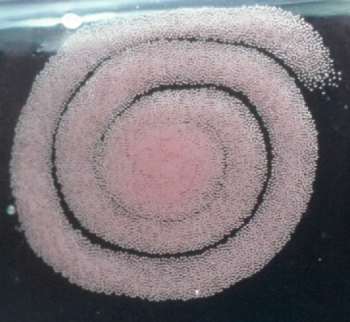
Concerning message #16102:
Hi Bill and Dave,
Th egg mass in Kevin Lee's photos was probably laid by an aeolid nudibranch. Here is an image of the egg mass of Limacia cockerelli, which is a pink ribbon laid flat against the substrate. This one was laid in captivity on the side of a glass jar and had eggs averaging 95 microns in diameter.
Locality: Cape Arago, Intertidal, Oregon, USA, Pacific Ocean, July 1984, Adults slugs collected from rocky shore. Length: 14 mm (egg mass diameter). Photographer: Jeff Goddard.
Best wishes,
Jeff
goddard@lifesci.ucsb.edu
Goddard, J.H.R., 2006 (Mar 23) Re: Eggs? of Limacia cockerelli. [Message in] Sea Slug Forum. Australian Museum, Sydney. Available from http://www.seaslugforum.net/find/16157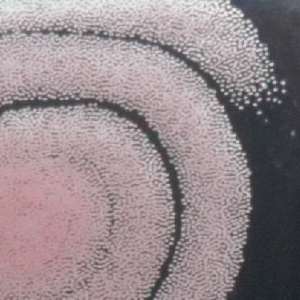
Thanks Jeff,
Bill Rudman
Eggs? of Limacea cockerelli
March 22, 2006
From: Kevin Lee
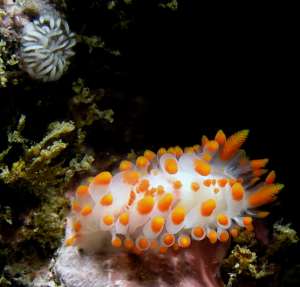
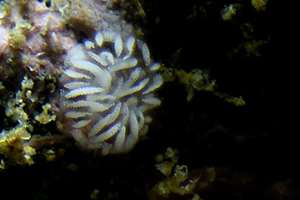
Attached is a photo of a Limacia cockerelli. When veiwing it on my computer monitor, I noticed what seems to be a circular mass of "eggs", in the upper left-hand corner of the image. Do you know if these are eggs of the L. cockerelli?
Locality: Shaw's Cove, Laguna Beach, 20 feet, California, Eastern Pacific, 11 June 2005. Length: 0.5 inch. Photographer: Kevin Lee.
And might the SeaSlug Forum have a compendium of Opisthobranch eggs on file?
Tnx, K:-)
diverkevin@gmail.com
Lee, K., 2006 (Mar 22) Eggs? of Limacea cockerelli. [Message in] Sea Slug Forum. Australian Museum, Sydney. Available from http://www.seaslugforum.net/find/16102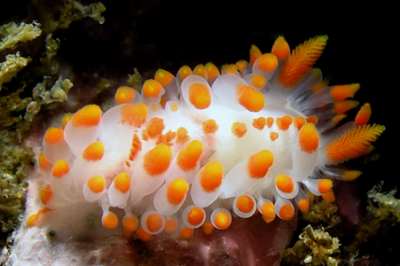
Dear Kevin,
The identification of lone egg masses can be quite problematic. Unless you obseverve an adult laying the ribbon, or the species is extremely common and there are lots of adults and ribbons scatterred around, you can't really give an intelligent ID.
To be honest with you I am not sure I have ever accurately documented the egg mass of Limacea cockerelli. I am sure Jeff Goddard has, and hopefully he will lend a hand here.
Concerning a compendium of egg masses on the Forum - no there is not a 'single' compendium, but you can always use Bill's SEARCH on "eggs."
Best wishes,
Dave Behrens
Limacia or Laila cockerelli from Brish Columbia
January 25, 2006
From: Marli Wakeling
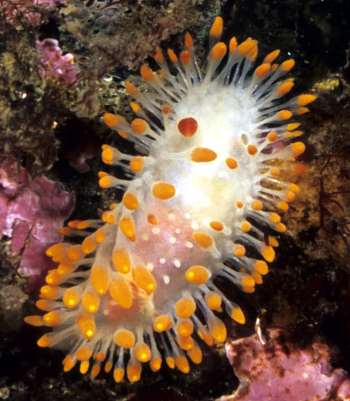
Hi Bill,
I noticed that Laila cockerelli is called Limacia cockerelli in the new Behren's Nudibranch Behaviour book. Has it been reclassified? Here is one from Campbell River.
Locality: Copper Cliffs, Campbell River, British Columbia, Canada. Pacific coast. Depth: 45 feet. Length: 12 mm. 10 October 2005. Rocky wall. Photographer: Marli Wakeling
Cheers,
Marli
scubamarli@gmail.com
Wakeling, M., 2006 (Jan 25) Limacia or Laila cockerelli from Brish Columbia. [Message in] Sea Slug Forum. Australian Museum, Sydney. Available from http://www.seaslugforum.net/find/15188Dear Marli,
Yes, this species has been moved. In my Supplement to Pacific Coast Nudibranchs, 2nd Edition I mention that Laila MacFarland 1905 was synonymized with Limacia Muller, 1781, by Valdes et.al. 2000.
-
Vallès, Y.; Valdés, A.; Ortea, J. 2000. On the phanerobranch dorids of Angola (Mollusca, Nudibranchia): A crossroads of temperate and tropical species. Zoosystema, 22(1): 15-31.
Best wishes,
Dave Behrens
Laila cockerelli colour variation
October 11, 2002
From: Marli Wakeling
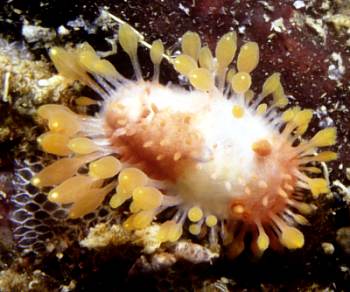
Hi Bill,
Here is another colour variation in Laila cockerelli which seems to fall in between the others I've sent in previously.
Location: Bowyer Island, Howe Sound, British Columbia, Canada.
Date: August 2002
Depth: 45 feet
Length: 1 cm
Photograph: Marli Wakeling
Marli
scubamarli@excite.com
Wakeling, M., 2002 (Oct 11) Laila cockerelli colour variation. [Message in] Sea Slug Forum. Australian Museum, Sydney. Available from http://www.seaslugforum.net/find/8135Thanks Marli,
I guess the white lace-work on the lower left of the photo is the remains of a bryozoan colony Laila has been feeding on
Bill Rudman
Laila cockerelli - interesting behaviour
August 7, 2002
From: Sean Kearney
Dear Bill,
I recently observed a small (10 mm or so) Laila cockerelli "flexing" its dorsal papillae in a sort of "oars up" manner such as might be seen when whitewater rafters get through an exciting rapid. It looked like it was winking. I was on a dive in the Pt. Loma kelp beds off of San Diego, California at a depth of about 15 meters and was surprised to see how quickly it moved. Any ideas on this behavior?
Thanks in advance,
Sean Kearney
skearney@dc.rr.com
Kearney, S. , 2002 (Aug 7) Laila cockerelli - interesting behaviour. [Message in] Sea Slug Forum. Australian Museum, Sydney. Available from http://www.seaslugforum.net/find/7722Dear Sean,
I am sure someone from California can let us know if this is usual behaviour for Laila cockerelli.
Some species rhythmically contract parts of their body, such as their gills, their cerata, or other dorsal papillae, as part of their blood circulation system. Blood circulation in slugs and snails is a little different from the efficient system we have in out bodies where the heart pumps blood around in a closed system of veins and arteries. Snails and slugs have a heart to pump the blood around, but the system of veins and arteries is rather open ended. Although the blood is pumped to and from the gills, the digestive system, and otjer major organs through blood vessels, much of the blood lies free in the body cavity. To ensure this 'loose' blood doesn't just stagnate in one place, regularly motion of the gills and papillae etc., helps to move the blood around the body. It is possible that what you have observed is one of Laila's ways of moving blood from the papillae, where it probably becomes oxygenated, to other parts of the body.
Cheers,
Bill Rudman
Laila cockerelli from British Columbia
April 4, 2002
From: Marli Wakeling
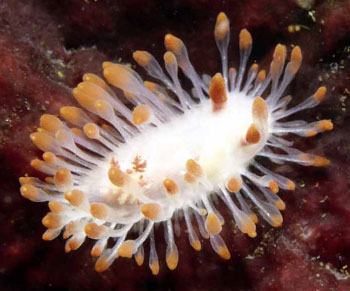
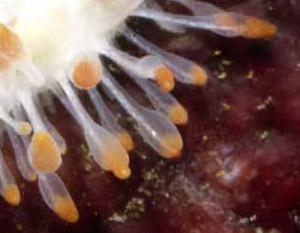
Hi Bill,
Here is another Laila cockerelli with the usual colouration from Southern Vancouver Island, at Race Rocks Marine Preserve. This is near Victoria, British Columbia.
DIVE SITE: Race Rocks, Vancouver Island, British Columbia, Canada.
DEPTH: 45 feet
LENGTH: 8mm
PHOTO BY: Marli Wakeling
Marli
scubamarli@excite.com
Wakeling, M., 2002 (Apr 4) Laila cockerelli from British Columbia. [Message in] Sea Slug Forum. Australian Museum, Sydney. Available from http://www.seaslugforum.net/find/6630Thanks Marli,
Bill Rudman
Laila cockerelli from Shaw's Cove
January 30, 2002
From: Bruce Wight
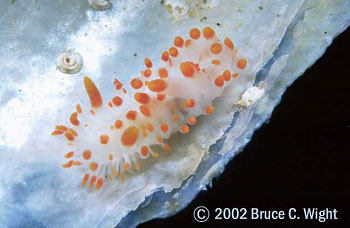
Hi Guys,
Here is a photo of Laila cockerelli from our recent dive [January, 2002] at Shaw's Cove in Laguna Beach [California].
Take care,
Bruce Wight
bwproductions@earthlink.net
Wight, B., 2002 (Jan 30) Laila cockerelli from Shaw's Cove. [Message in] Sea Slug Forum. Australian Museum, Sydney. Available from http://www.seaslugforum.net/find/6117Thanks Bruce,
Bill Rudman
Laila cockerelli colour forms from Canada
November 2, 2001
From: Marli Wakeling
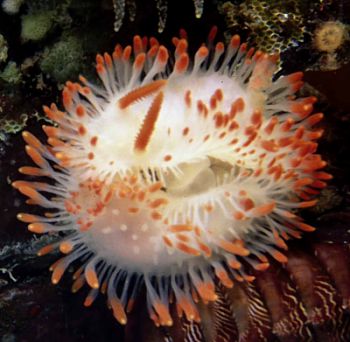
Hi Bill,
Here are three different colour forms of Laila cockerelli, all found on the same site, and close to each other.
Dive Site: Steep Island, Vancouver Island, British Columbia, Canada. Depth: 45 feet. October 2001
UPPER RIGHT: • The Southern or unspotted variety - 3cm. mating pair.
LOWER LEFT: The 'Northern' or spotted variety - 2cm.
LOWER RIGHT: The third, or blotchy variety - 1 cm
Photographs: Marli Wakeling
Marli.
scubamarli@excite.com
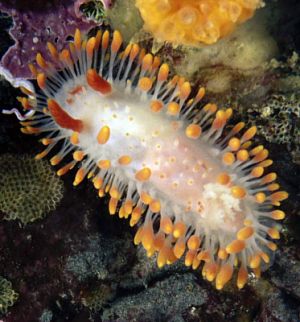
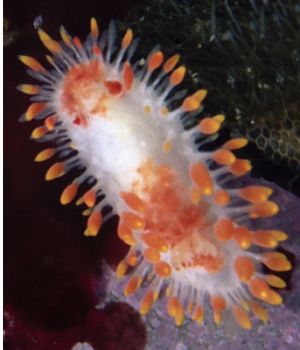
Dear Marli,
Thanks for this interesting set of photos
Bill Rudman
Laila cockerelli: 3rd colour variation
June 14, 2001
From: Marli Wakeling
Hi Bill,
Just wanted to let you know that the third colour variation I found in Barclay Sound, BC. My camera was dead, but I had a friend photograph it and Dave Behrens confirmed it... along way from its "home" in Santa Barbara, California. I guess it's because there aren't many of us looking that the ranges are so inaccurate in this part of the world, and I venture to guess elsewhere. Keep up the fine work!
Marli Wakeling
scubamarli@excite.com
Wakeling, M., 2001 (Jun 14) Laila cockerelli: 3rd colour variation. [Message in] Sea Slug Forum. Australian Museum, Sydney. Available from http://www.seaslugforum.net/find/4572Dear Marli,
Thanks for keeping us up to date on this information. I often think that the 'known distributions' of many nudibranchs tend to tell us more about the known distributions of opisthobranch workers rather than that of the slugs.
Bill Rudman
Laila cockerelli from Canada
December 18, 2000
From: Marli Wakeling
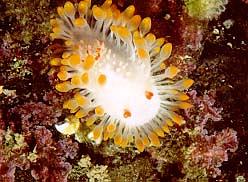
Hi Bill,
More photos from British Columbia, Canada.
Here is a Laila cockerelli. I have only seen it a few times. It is, in British Columbia, fairly small, about 1.5-3 cm. when I have seen it. This was taken near Victoria, BC at a site called Race Rocks.
Marli.
scubamarli@excite.com
Wakeling, M., 2000 (Dec 18) Laila cockerelli from Canada. [Message in] Sea Slug Forum. Australian Museum, Sydney. Available from http://www.seaslugforum.net/find/3314Dear Marli,
Sorry this has taken a while to post. I'll get you other photos organised in the next few days
Best wishes,
Bill Rudman.
Laila cockerelli - 3rd colour form
December 18, 2000
From: Marli Wakeling
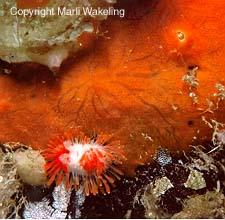
Dear Bill
I found this Laila cockerelli near Vancouver, British Columbia, Canada, in 50 feet, in December, 2000. The red blotches are different from the other varieties. It is apparently only been found on one reef in California, and may possibly be a distinct species. It is approxiamately 8 mm in length. The dive site is called Bowyer Island, in Howe Sound.
Marli
scubamarli@excite.com
Wakeling, M., 2000 (Dec 18) Laila cockerelli - 3rd colour form. [Message in] Sea Slug Forum. Australian Museum, Sydney. Available from http://www.seaslugforum.net/find/3380Thanks Marli,
Bill Rudman.
Orange colour form of Laila cockerelli
July 6, 2000
From: Bruce Wight
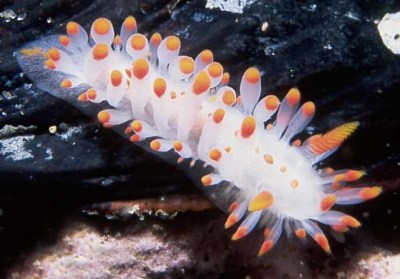
Hi Doc,
I saw Jeff's latest on Laila. I have always taken Laila for a scavenger. Next to Polycera atra, they are the most commonly seen polycerid in Laguna Beach were I do most of my beach diving (see attached photos all taken in Shaw's Cove, Laguna Beach, California). Unlike Polycera atra, which I usually find in the patches of Bugula, I normally see Laila cockerelli at the bottom of the mussel bed, inside the dead mussel shells, and I assumed they were feeding on the remains. I encountered a dead kelp crab (Pugettia producta) filled with well over a dozen of these little guys cleaning out the inside of the carapace, also in Laguna Beach.
Bruce Wight
bwproductions@earthlink.net
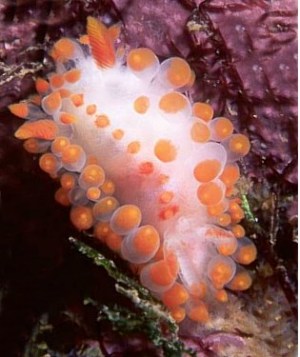

Thanks Bruce,
I wonder if anyone else has observed eating a bit of carrion? It would be quite an easy little test to set up to see if they were attracted to dead and decaying animals. The other possibility is that they have a negative response to light and shelter or hide inside holes and containers. Crab carapaces and mussel shells would do just as nicely. We have a common small octopus, which is very poisonous (Hapalochlaena sp), and it does just that, hiding in shells, bottles, beer cans.
Best wishes,
Bill Rudman.
Laila cockerelli from California
July 4, 2000
From: Jeff Goddard

Hi Bill,
Here is a photo of Laila cockerelli on its bryozoan prey, the orange brown colored Hincksina velata, at Cape Arago, Oregon. The white patches have already been grazed by the nudibranch. The red pink bryozoan is Eurystomella bilabiata, the sole prey of Hopkinsia rosacea. I have also enclosed a brief account of the biology of L. cockerelli for the Forum.
Best wishes,
Jeff
goddard@lifesci.ucsb.edu
Dear Jeff,
Thanks for the photo and information which is now the 'Laila cockerelli Page'.
Best wishes,
Bill Rudman.
